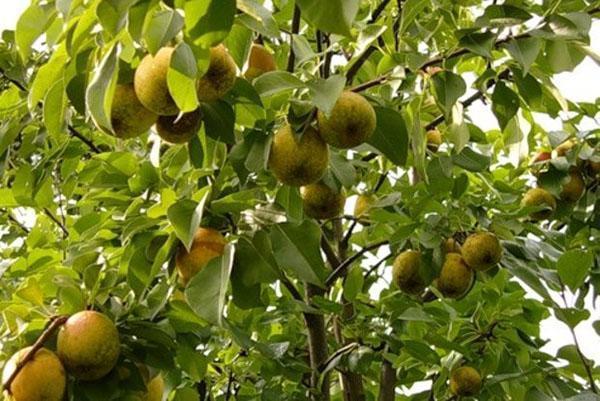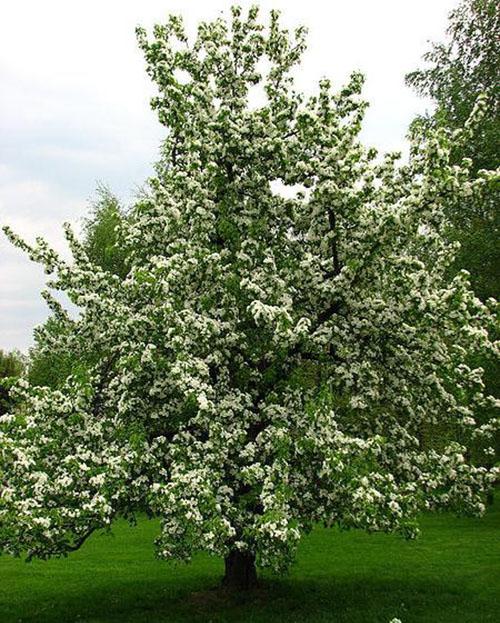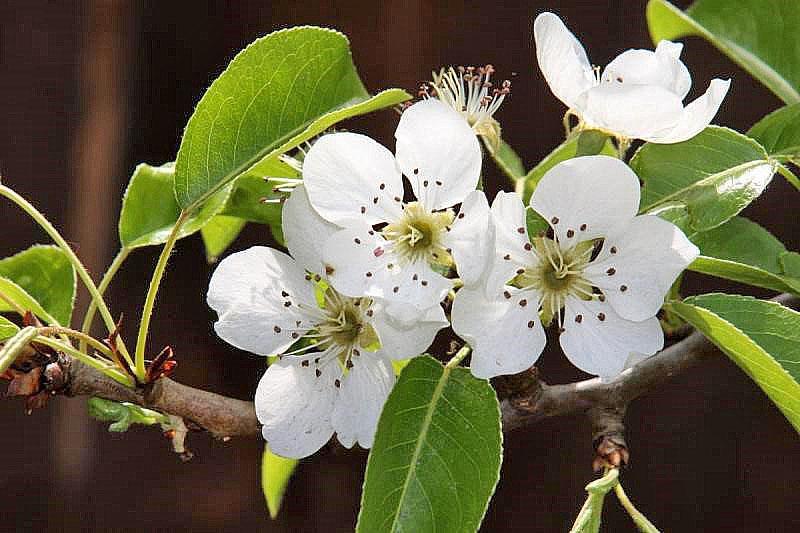We study the pear variety Severyanka by photo and description
 Severyanka (red-cheeked northerner) was bred by hybridization of 2 varieties in 1959 by P.N. Yakovlev. Grusha Severyanka, the description and photo, the plants of which are given below, were bred specifically for the northern regions, from which, in fact, it got its name. Today the pear is widespread in the Ural region.
Severyanka (red-cheeked northerner) was bred by hybridization of 2 varieties in 1959 by P.N. Yakovlev. Grusha Severyanka, the description and photo, the plants of which are given below, were bred specifically for the northern regions, from which, in fact, it got its name. Today the pear is widespread in the Ural region.
Appearance

 During the flowering period, the tree is covered with snow-white flowers. The flower has the shape of a saucer; white petals with smooth edges do not touch each other very much. One inflorescence consists of 4-6 flowers. The stigmas of the pistils are located below the anthers.
During the flowering period, the tree is covered with snow-white flowers. The flower has the shape of a saucer; white petals with smooth edges do not touch each other very much. One inflorescence consists of 4-6 flowers. The stigmas of the pistils are located below the anthers.
Fruit
 Severyanka pear variety does not differ in its large-fruited. On average, one fruit weighs 80-85 g, which is lower than the average of other varieties
Severyanka pear variety does not differ in its large-fruited. On average, one fruit weighs 80-85 g, which is lower than the average of other varieties
The maximum weight of a northerner's pear is 120 g.
Truncated-conical pears. The rind is firm and thick, but at the same time not coarse. A wide and small saucer. The seeds are large and not numerous. The color of the fruit at harvest is greenish yellow with a slight red tan. After some time, the pear is dominated by yellow color with small splashes of green with a pink blush. The flesh is creamy and not firm. The fruit tastes juicy, not tart, crunchy, with sweet-sour notes. The aroma is not strong. The fruits contain 11.8% sugar and 0.38% acid. Pears can be used not only for food, but also for cooking and preservation.
Harvest
 The description with a photo of a northerner pear includes the yield of the variety. The fruits ripen in early August. The pears are tightly fixed, but as soon as they ripen, they will crumble in a couple of days.
The description with a photo of a northerner pear includes the yield of the variety. The fruits ripen in early August. The pears are tightly fixed, but as soon as they ripen, they will crumble in a couple of days.
The pears are removed from the tree about a week before they are fully ripe - this allows their shelf life to be extended to 2 months.
Harvests from a young tree are obtained several years after planting. From a 6-7 year old tree, up to 20 kg of pears are obtained per season. An adult tree brings 45 - 60 kg of pears per year, and under favorable conditions, the figure can reach 100 - 110 kg.
Climatic conditions
The northerner pear, reviews of which say about its unpretentiousness, is widespread in the northern regions due to its stability. The trees are good for cold and harsh winters. And in cases of very high temperatures and freezing, the shoots quickly recover and the tree continues to bear fruit.
Drought tolerance is average. With scant rains and lack of watering, the fruits become smaller and lose their taste.
Planting and leaving
 The best place to plant any fruit tree is the sunny side. Planting and caring for a northerner pear is quite simple, but in order to get a good harvest, you need to adhere to some rules. For landing, a spacious place is chosen where there are practically no drafts.The pear sits in a pit 60 m deep and 90 cm wide, humus is poured onto the bottom and the pit is filled with water. As soon as the liquid has been absorbed, the seedling is carefully placed in the ground and sprinkled with earth and again watered with water.
The best place to plant any fruit tree is the sunny side. Planting and caring for a northerner pear is quite simple, but in order to get a good harvest, you need to adhere to some rules. For landing, a spacious place is chosen where there are practically no drafts.The pear sits in a pit 60 m deep and 90 cm wide, humus is poured onto the bottom and the pit is filled with water. As soon as the liquid has been absorbed, the seedling is carefully placed in the ground and sprinkled with earth and again watered with water.
You only need to buy two-year-old seedlings, it is believed that such trees take root best.
Main aspects of care:
- Caring for a northerner pear implies frequent watering during severe droughts.
- The tree is fertilized annually. For the winter, seedlings and already established young trees are well insulated, since an uncovered plant can suffer from severe frosts and die.
- In order for a tree to grow properly, its crown must be formed annually. There are several types of pruning: thinning and sanitary. Thinning the tree to increase its service life and obtain high yields. Sanitary pruning is only done when necessary when the tree is suffering from disease.

- Pears, like other trees, are subject to various diseases and pest attacks. So that your tree does not suffer, it must be treated in a timely manner with special solutions that can be purchased at any garden store.
Even an inexperienced gardener can understand from the photo and description of the northerner pear that the variety is perfect for growing in regions with cold climates. The variety is early ripening and unpretentious, and small pears are ideal for any use.